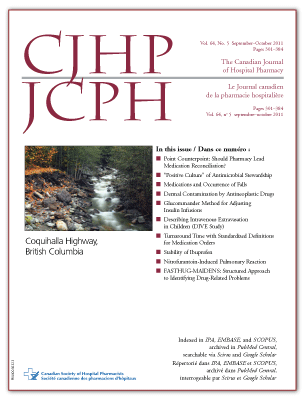Growing a “Positive Culture” of Antimicrobial Stewardship in a Community Hospital
DOI:
https://doi.org/10.4212/cjhp.v64i5.1065Keywords:
antimicrobial stewardship, prospective audit and feedback, Clostridium difficile, gestion responsable des antimicrobiens, vérification prospective et rétroactionAbstract
ABSTRACTBackground: Promoting the appropriate use of antimicrobials is a core value of antimicrobial stewardship. Prospective audit and feedback constitute an effective strategy for reducing the cost and use of antimicrobials, as well as their adverse effects, such as infection with Clostridium difficile.
Objective: To evaluate the antimicrobial stewardship program in the intensive care unit at the authors’ hospital, in order to determine the cost and utilization of antimicrobials, as well as the rate of nosocomially acquired C. difficile infection.
Methods: An infectious diseases team, consisting of a physician and a pharmacist, performed prospective audit and feedback during a pilot study (April to June 2010). The team met with the intensive care unit team daily to discuss optimization of therapy. The cost and utilization of antimicrobial drugs, as well as rates of C. difficile infection, were compared between the pilot period and the same period during the previous year (April to June 2009). For 3 months after the pilot phase (i.e., July to September 2010), the strategy was continued 3 days per week.
Results: After introduction of the antimicrobial stewardship program, there was a significant reduction in the cost of antimicrobial drugs: $27 917 less than during the same period in the previous year, equivalent to a reduction of $15.45 (36.2%) per patient-day ($42.63 versus $27.18). Utilization of broad-spectrum antipseudomonal antimicrobial agents was also significantly lower, declining from 63.16 to 38.59 defined daily doses (DDDs) per 100 patient-days (reduction of 38.9%). After the pilot period, the rate declined further, to 28.47 DDDs/100 patient-days. During the pilot period, there were no cases of C. difficile infection, and in the post-pilot period, there was 1 case (overall rate 0.42 cases/1000 patient-days). This rate was lower than (but not significantly different from) the rate for April to September 2009 (1.87 cases/1000 patientdays). There were no differences in mortality rate or severity of illness.
Conclusion: The antimicrobial stewardship program in this community hospital was associated with significant decreases in antimicrobial costs and in utilization of antipseudomonal antimicrobial agents and a nonsignificant decrease in the rate of C. difficile infection. Knowledge exchange, peer-to-peer communication, and decision support, key factors in this success, will be applied in implementing the antimicrobial stewardship program throughout the hospital.
RÉSUMÉ
Contexte : La promotion de l’utilisation appropriée des antimicrobiens est l’une des pierres angulaires de la gestion responsable des antimicrobiens. Les vérifications prospectives et la rétroaction constituent une stratégie efficace pour réduire le coût et l’utilisation des antimicrobiens ainsi que leurs effets indésirables, comme l’infection à Clostridium difficile.
Objectifs : Examiner le programme de gestion responsable des antimicrobiens à l’unité de soins intensifs de l’hôpital des auteurs, afin de déterminer le coût et l’utilisation des antimicrobiens de même que le taux d’infections nosocomiales à C. difficile.
Méthodes : Une équipe des maladies infectieuses formée d’un médecin et d’un pharmacien ont effectué une vérification prospective et une rétroaction durant l’étude pilote (avril à juin 2010). L’équipe a rencontré l’équipe de l’unité de soins intensifs quotidiennement pour discuter de l’optimisation du traitement. Le coût et l’utilisation des antimicrobiens de même que les taux d’infections à C. difficile compilés pour la période de l’étude ont été comparés à ceux obtenus durant la même période l’année précédente (avril à juin 2009). Pendant les trois mois suivant l’étude pilote (c.-à-d. de juillet à septembre 2010), la stratégie a été poursuivie à raison de trois jours par semaine.
Résultats : On a observé après la mise en place du programme de gestion responsable des antimicrobiens une diminution significative du coût des antimicrobiens : 27 917 $ de moins qu’à la même période de l’année précédente, soit une réduction de 15,45 $ (36,2 %) par journéepatient (42,63 $ contre 27,18 $). Le recours à des antibactériens antipseudomonas à large spectre a également grandement diminué, passant de 63,16 à 38,59 doses journalières définies (Defined Daily Dose [DDD]) par 100 journées-patients (réduction de 38,9 %). Après l’étude pilote, ce taux a continué de baisser, passant à 28,47 DDD par 100 journées-patients. Durant l’étude pilote, aucun cas d’infection à C. difficile n’a été observé et durant la période suivant l’étude pilote, un cas a été observé (taux global de 0,42 cas par 1000 journées-patients). Ce taux s’est avéré inférieur (quoique non significativement différent) au taux observé entre avril et septembre 2009 (1,87 cas par 1000 journéespatients). Aucune différence dans le taux de mortalité ou la gravité de la maladie n’a été notée.
Conclusions : Le programme de gestion responsable des antimicrobiens de cet hôpital communautaire a été associé à des diminutions significatives du coût des antimicrobiens et de l’utilisation des antimicrobiens antipseudomonas et à une diminution non significative du taux d’infections à C. difficile. Le partage des connaissances, l’échange entre les pairs et les outils d’aide à la décision, des facteurs clés du succès de ce programme, seront utilisés dans la mise en oeuvre du programme de gestion responsable des antimicrobiens à l’échelle de l’hôpital.
Downloads
Published
Issue
Section
License
Copyright © Canadian Society of Healthcare-Systems Pharmacy.
After publication of a manuscript in the CJHP, the authors of the manuscript must obtain written permission from the CSHP (publications@cshp.ca) before reproducing any text, figures, tables, or illustrations from the work in future works of their own. If a submitted manuscript is declined for publication in the CJHP, all said rights shall revert to the authors. Please note that any forms (e.g., preprinted orders and patient intake forms) used by a specific hospital or other health care facility and included as illustrative material with a manuscript are exempt from this copyright transfer. The CJHP will require a letter from the hospital or health care facility granting permission to publish the document(s).










